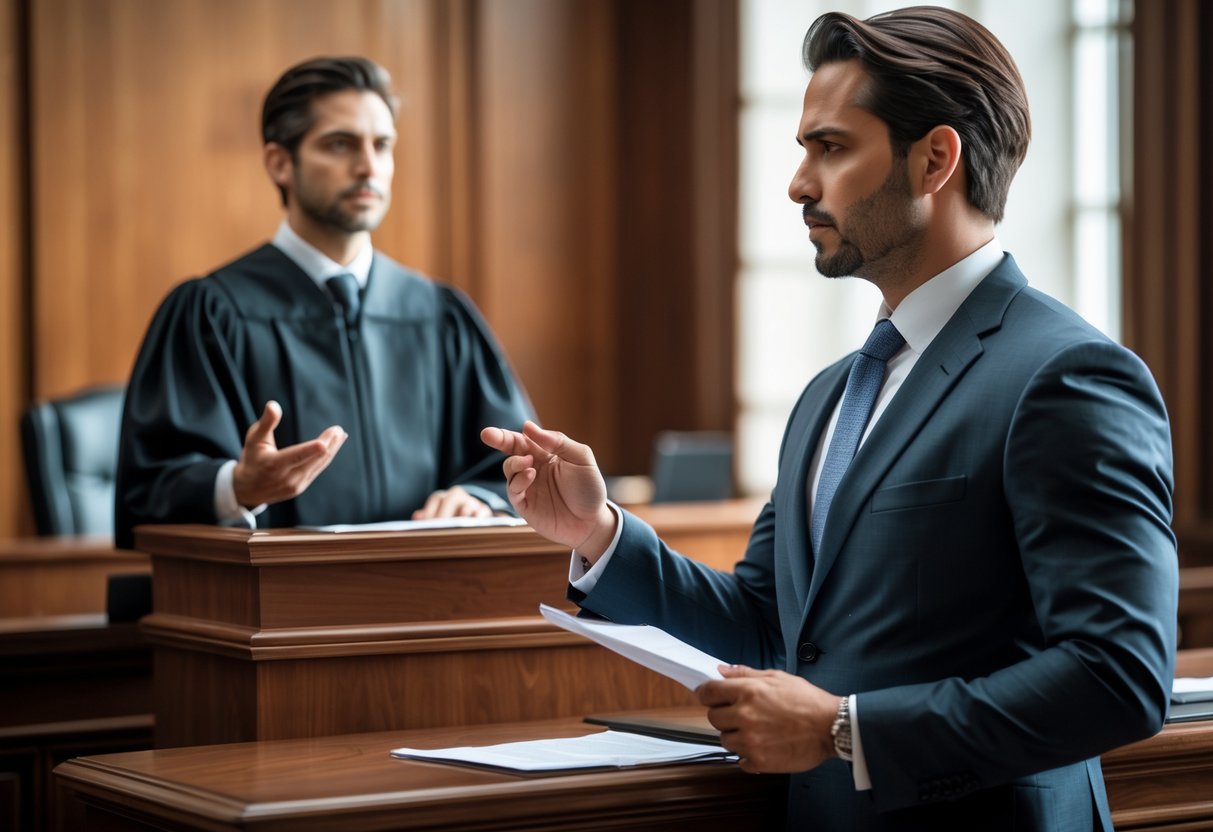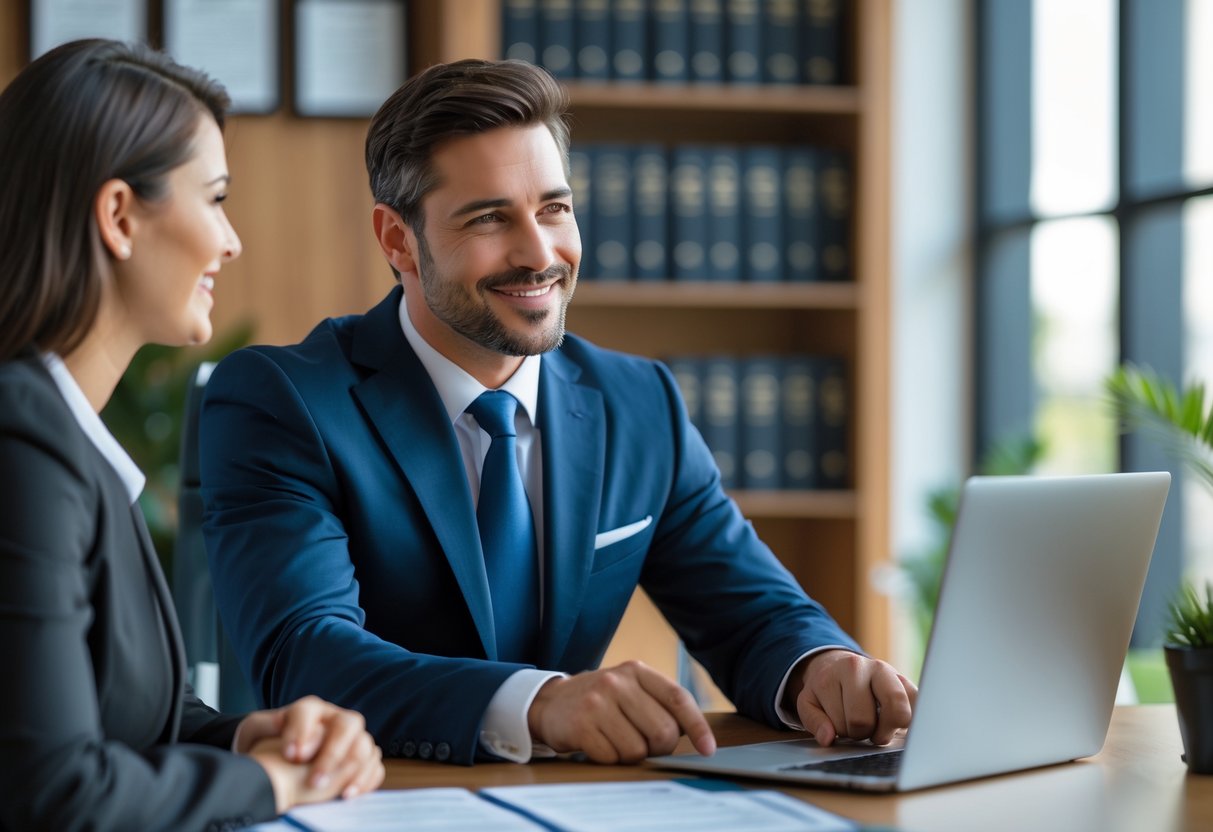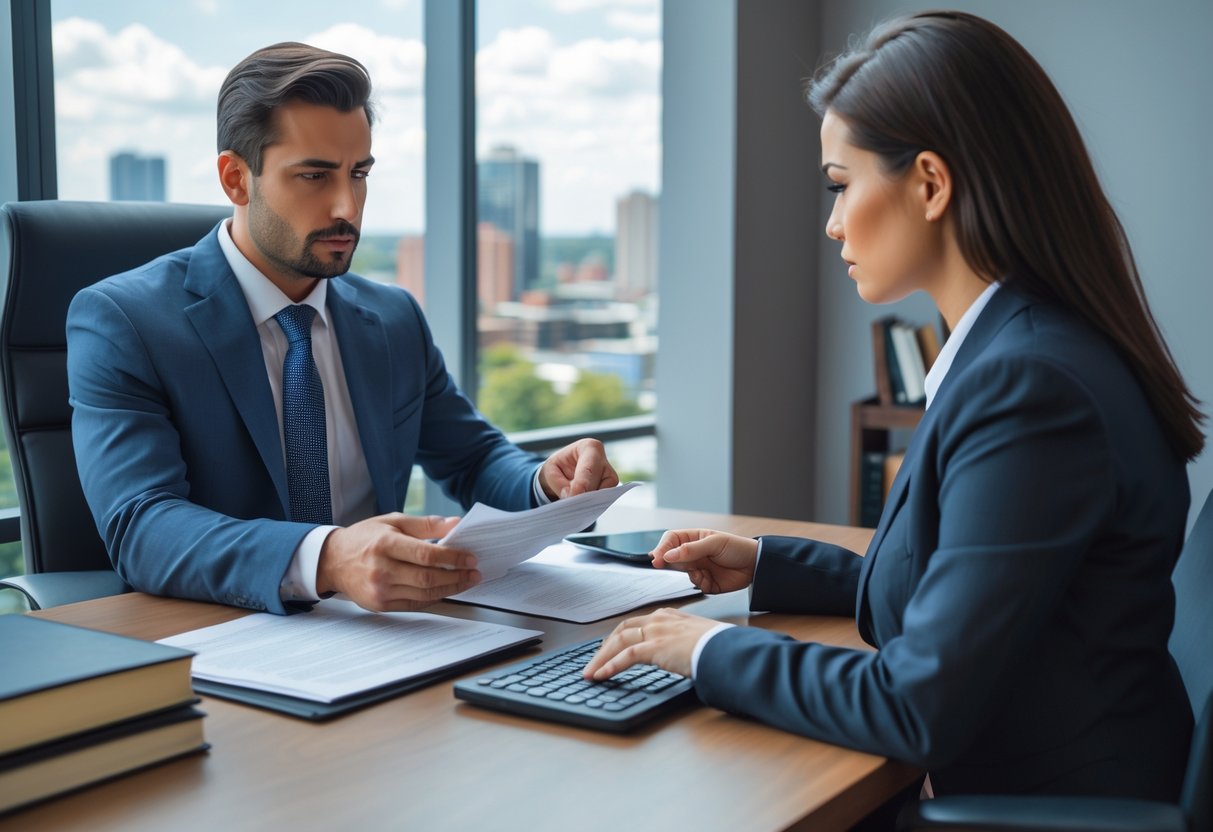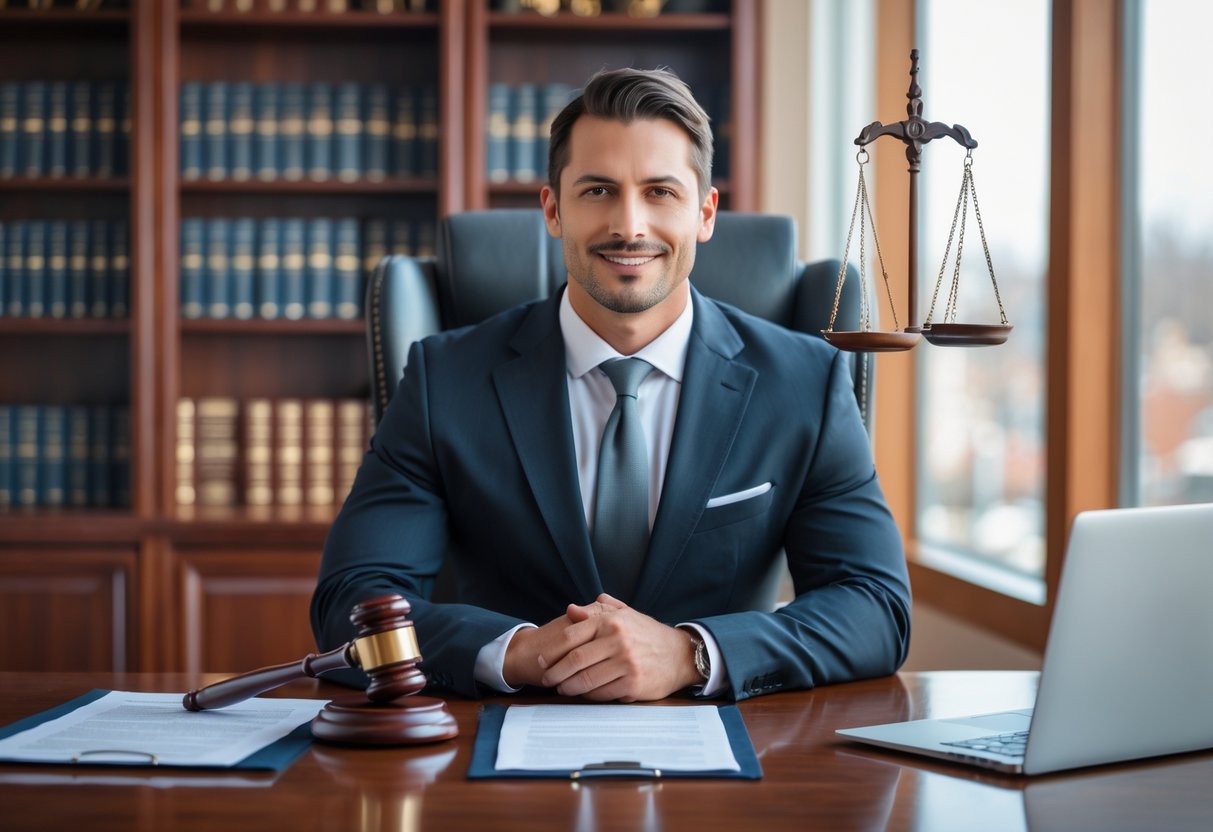Every trial comes down to the closing arguments. As defense attorneys, our approach during this final stage can make a big difference in how the jury sees our client’s case.

We need to clearly explain the main facts, address any weak points, and remind the jury of the standard of proof. A strong closing argument keeps the focus on our client’s rights and the evidence the prosecution did not provide.
Let’s look at the factors we should always keep in mind when preparing our closing arguments. This will help us stay organized, persuasive, and effective in court.
The Purpose of Closing Arguments
Closing arguments let us present the final summary of our case and clarify important details. We use this phase to address the jury directly and explain how the evidence fits into our trial strategy.
Role in the Trial Process
During a trial, the closing argument serves as our last chance to speak directly to the jury before they decide the verdict. We use this time to organize our points and highlight facts that support our client’s innocence or weaken the prosecution’s story.
We do not present new evidence, but we can draw together the information already given. The main goal is to make it easier for jurors to remember key facts that benefit our case.
We also aim to simplify legal concepts, answer questions that may have arisen during testimony, and guide the jury on how to interpret the law as it applies to the evidence. This helps give our client the best chance for a favorable outcome.
- Pointing out witnesses or evidence that support our position.
- Addressing flaws or inconsistencies in the other side’s claims.
- Explaining reasonable doubt if the case is criminal.
- Reminding jurors of their duty to decide based only on the facts.
Differences from Opening Statements
An opening statement comes right after jury selection and before any evidence is shown. The main goal of the opening statement is to give the jury an idea of what we believe the evidence will show. It is more of a preview than an argument.
By contrast, closing arguments come after the presentation of all evidence and testimony. Here, we are allowed to argue our point of view, comment on the evidence, and challenge the other side’s version of events. Our job is to make clear connections between facts and our overall trial strategy.
Unlike the opening statement, the closing argument can directly urge the jury to find a certain way based on the facts. We use persuasive language and detailed references to testimony, exhibits, and cross-examinations.
| Feature | Opening Statement | Closing Argument |
|---|---|---|
| Timing | Start of trial | End of trial |
| Purpose | Preview evidence | Summarize and argue facts |
| Allowed to Argue? | No | Yes |
| References Evidence? | Only expected | Yes, uses actual evidence presented |
Structuring the Defense Closing Argument
We need to build our defense closing argument in a way that is logical, easy to follow, and persuasive. To do this, we should focus on developing a central theme, organizing the body with key evidence, and finishing with a strong conclusion.
Crafting a Central Theme
A central theme is the foundation for any successful closing argument. This theme should be clear, memorable, and tied to the facts of the case. For example, if our client is accused of theft but the evidence is weak, our theme might be, “Doubt means not guilty.”
We should introduce this theme at the start and return to it often. Repeating the theme helps the jury remember why the evidence supports our client. The theme should connect with the jury’s sense of fairness.
We need to use simple language and avoid complicated terms. Creating a theme that the jury can repeat in their own words means they are more likely to accept it.
Outlining the Body
The body of our closing argument is where we present and connect the facts to our central theme. We need to highlight the evidence that supports our case and point out problems or inconsistencies in the prosecution’s story. Using a logical order such as the order the events happened or by issue—helps make our points clearer.
Our body should include:
- Direct references to evidence and testimony
- Explanations for why the prosecution’s case falls short
- Clear statements about what the jury should believe based on the facts
We want to speak in plain terms. When possible, we should use numbers and exact details, like, “Three witnesses gave three different stories about what happened.” This makes our argument stronger and easier to follow.
Developing a Strong Conclusion
Our conclusion is our final chance to leave an impression on the jury. We should restate our central theme and the most important reasons the evidence supports our client. Here, we remind the jury of any weaknesses in the prosecution’s case.
A strong conclusion answers the main questions the jury will have. We must be direct: “The law says if there is reasonable doubt, you must find our client not guilty.”
We finish by thanking the jury and urging them to rely on the facts and the law. Our goal is to make sure the key message we started with is the one they remember as they begin deliberations.
Presenting and Challenging Evidence
When delivering our closing argument, we must focus on strengthening our case by emphasizing helpful exhibits and raising doubts about the prosecution’s main evidence. Using visual aids and clear presentations can help clarify complex facts for the jury.
Highlighting Favorable Evidence
We should direct attention to every piece of evidence that supports our defense. This includes, for example, physical exhibits, witness testimony, or documents that back up our version of events.
Listing these items with simple explanations helps make our points clear for the jury. For instance:
| Exhibit | What It Shows |
|---|---|
| Phone Records | Our client was not at the scene |
| Witness A | Saw someone else at the location |
| GPS Data | Confirms a different timeline |
We need to remind the jury how each item connects to our client’s innocence or casts doubt on guilt. We can use phrases like “This exhibit shows…” or “This testimony proved…” for strong impact.
Addressing Key Evidence Presented by the Prosecution
We must examine the prosecution’s main evidence in detail and point out any weaknesses. If there are inconsistencies in witness stories, missing details in reports, or doubts about scientific tests, we should explain each issue clearly.
We can create simple bullet points to help the jury remember our challenges:
- The timeline does not match known facts
- Key witness changed their story on cross-examination
- Testing method was not reliable
By focusing on facts and using clear examples, we make it easier for the jury to see why the prosecution’s evidence is not strong enough for a conviction.
Demonstratives and Visual Aids
We can use demonstratives—like maps, timelines, charts, or animations to simplify complex facts. For example, if our timeline is important, a well-made chart can help jurors understand the sequence of events.
Animations can replay or recreate scenes, making it easy to spot problems in the prosecution’s theory. Labels, arrows, and straightforward graphics make comparisons clear.
When we present exhibits as visual aids, we help jurors remember key points and connect them to what was shown during the trial. This makes our arguments more organized and easier to follow.
Persuasion Techniques for Defense Attorneys
When preparing closing arguments, we must focus on being both convincing and relatable. The best way to reach jurors is by combining facts, logical points, and emotional elements.
Logical Reasoning and Reasonable Inferences
We need to use facts and evidence from the trial as the base of our argument. Logical reasoning helps us guide the jury step-by-step through our client’s story.
We should point out gaps or weaknesses in the prosecution’s case. Highlighting inconsistencies, missing details, or flawed logic makes the jury question the evidence against our client.
- Clearly organize main points.
- Use evidence from the trial.
- Connect facts with simple logic.
- Challenge assumptions using credible information.
Making reasonable inferences means drawing sensible conclusions that fit the facts. We do not exaggerate or stretch the evidence. By sticking to what is reasonable, we help the jury trust our message.
Emotional Appeals and Storytelling
We can use pathos, or emotional appeal, to connect with jurors on a personal level. People often remember stories more than dry facts.
Telling our client’s story allows us to show the context and human side behind the case. This can include details about character, motives, or struggles. We should present it in a clear, respectful way never manipulating feelings, but showing why our client deserves a fair look.
- Show relatable emotions (fear, hope, regret).
- Use simple language and real-life examples.
- Frame our client as a real person, not just a defendant.
Mixing facts with feelings helps the jury see our client in a new light, possibly leading to more understanding.
Using Rhetorical Techniques
Rhetorical techniques help us make our message stronger and clearer. Repetition helps important ideas stick in the jury’s mind. Analogies and examples help explain complex facts.
We should ask direct questions to make jurors think about key points. Using short and clear sentences can help our message sound more certain.
| Technique | Example | Purpose |
|---|---|---|
| Repetition | “The evidence is clear…” | Reinforce main ideas |
| Analogies | “Like a puzzle missing pieces…” | Make concepts relatable |
| Direct address | “You must decide…” | Engage the jury directly |
Using these tools properly keeps our argument focused and persuasive.
Addressing Credibility and Witness Testimony
When we prepare closing arguments, we must look closely at how the jury views each witness. The trustworthiness of a witness and the accuracy of their story can influence the verdict.
Challenging the Credibility of Witnesses
We need to question if each witness is believable. Credibility means whether the jury thinks the witness is telling the truth. We can raise doubts by pointing out contradictions or faulty memories.
For example, if a witness changes their story, we should highlight these differences. Past misrepresentations or bias like holding a grudge can also affect how believable they are. It is useful to use a table or list to remind the jury of inconsistent statements:
| Witness | Key Contradiction | Possible Bias |
|---|---|---|
| John Smith | Changed timeline twice | Angry at defendant |
| Lisa Green | Forgot key details | Close friend of victim |
Bringing out these points tells jurors they need to think carefully before trusting this testimony. We do not attack the person, but focus on facts and logic.
Analyzing Witness Testimonies
We help jurors understand what each witness actually said by comparing their testimony with other evidence. If a witness’s story does not fit the facts, it weakens their statement.
We can walk the jury through important testimony, pointing out gaps or things that do not add up. This helps jurors see if the testimony is based on real memory or guesses.
If there are signs of confusion or details that changed, we highlight them. We should always point out which witness statements are reliable and which may not be trustworthy because of mistakes or misrepresentations.
By carefully analyzing the witness testimonies, we guide the jury to focus on what is most clear and believable based on the evidence.
Counterarguments, Rebuttal, and Defense Strategy
We need to challenge the prosecution by clearly addressing their arguments and using strong logic. Organizing the facts in a clear order helps us show why our client should not be held responsible.
Anticipating and Countering the Prosecution’s Arguments
We review every argument the prosecution might use against our client. Anticipating their main points lets us prepare specific responses, which is crucial for a strong rebuttal.
We make a list of the prosecution’s claims and compare them to the actual evidence. If a claim lacks proof or is based on weak facts, we show this directly. For example, if the prosecution says our client was at the scene, we examine witness statements and alibis to counter that point.
During our closing argument, we refute their strongest points first. We explain issues in logic or gaps in evidence so the jury has doubts about their story. We keep our tone logical and avoid emotional language, focusing instead on what can be shown or disproved.
Organizing Timelines and Demonstrating Liability or Lack Thereof
We often create timelines that explain the events clearly. Laying out a series of events helps us demonstrate if our client was truly involved or not.
| Time | Event | Evidence |
|---|---|---|
| 6:00 PM | Client leaves work | Security footage |
| 6:30 PM | Incident occurs | Phone records |
| 7:00 PM | Client seen elsewhere | Witness testimony |
By organizing details this way, we can point out where the prosecution’s timeline is inconsistent or impossible. If there is no proof our client was at the scene, we argue that there is no solid liability.
We highlight missing links and focus the jury’s attention on any gaps. This helps us show reasonable doubt and strengthens our defense.
Key Legal Standards in Defense Closings
Defense attorneys must follow clear legal rules during closing arguments in criminal cases. We have a duty to address the standards that the jury will use, especially the burden of proof and how the law should guide their decision.
Burden of Proof and Reasonable Doubt
In criminal cases, the prosecution carries the burden of proof. This means they must prove every element of the crime beyond a reasonable doubt. As defense attorneys, we focus on reminding the jury that if there is any real uncertainty about the defendant’s guilt, they must find our client not guilty.
We should avoid trying to prove innocence or shifting the burden to our side. Instead, we highlight gaps in the prosecution’s evidence and stress that unanswered questions mean reasonable doubt remains. Using real-world examples can help jurors understand this standard. The law does not require proof beyond all possible doubt just proof beyond reasonable doubt.
We might use a table, like below, to outline what reasonable doubt is and is not:
| What It Is | What It Isn’t |
|---|---|
| Honest uncertainty | Every possible doubt |
| Doubt based on evidence | Imagined doubt |
| Doubt that is reasonable | Speculative or trivial |
Jury Instructions and Legal Proceedings
Jury instructions are directions from the judge that tell the jury how to apply the law to the facts of the case. In our closing arguments, we reference key instructions the jury has heard, such as how to weigh evidence, the definition of reasonable doubt, and how to interpret their duties.
We must not misstate or alter these instructions. Instead, we guide jurors back to the judge’s words to support our arguments. If the prosecution’s argument ignores or twists a key instruction, we need to correct the record respectfully.
Pointing to language in the official jury instructions keeps our arguments grounded in the law. We often read short, important lines from the instructions to remind jurors of their responsibilities and ensure the fairness of the legal process.
Strengthening the Jury Connection
Building trust and understanding with the jury is important for a successful closing argument. We need clear strategies that help our message stay with jurors as they head into deliberation.
Effective Use of Repetition and Call to Action
Repeating the main themes of the case helps jurors remember key facts. When we restate important points, we make it easier for jurors to recall those ideas during deliberation.
We should identify the core issues in our client’s case and repeat them using clear, familiar language. Using short phrases like “reasonable doubt” or “lack of evidence” ties our argument together. This makes our closing more effective.
A call to action is also important. We need to clearly tell the jury what verdict we believe is right and explain why. For example, saying “We ask you to find our client not guilty because the evidence does not support conviction” is direct and easy to remember.
- Restate important facts
- Use easy-to-remember phrases
- Ask directly for a specific verdict
Avoiding Inflammatory Language and Personal Opinions
Jurors rely on us to be clear and fair. Using overly emotional or angry language can damage our credibility and distract from the facts.
We should avoid calling witnesses or the prosecution names. Instead, we must focus on what the evidence shows and leave out personal feelings. Sharing personal opinions can also be risky. Jurors care about the evidence, not our personal beliefs.
If we stick to the facts in a calm tone, jurors are more likely to trust us and stay focused on their job. This helps create a positive impression during jury deliberation and keeps attention on the evidence rather than emotions.
Tips to Avoid Problems:
- Stay calm and respectful
- Focus on facts, not feelings
- Do not insult anyone in the courtroom
Common Pitfalls and Adaptability in Closing Arguments
As defense attorneys, we face several challenges during closing arguments. Avoiding errors and making real-time adjustments can greatly improve our effectiveness in court.
Avoiding Common Mistakes
We often see certain mistakes repeat during closings. One frequent error is simply repeating evidence without tying it to our main defense theme. This can cause jurors to lose interest or miss our key points.
Another common pitfall involves using overly emotional language or exaggerating facts. This can damage credibility and make us appear less trustworthy to jurors. Instead, we should focus on facts and remain consistent with our case theory.
We also want to avoid attacking the prosecution directly or criticizing the legal process. Jurors might see this as disrespectful or unprofessional. Instead, we should calmly point out weaknesses in the prosecution’s case and highlight reasonable doubt.
Checklist for avoiding mistakes:
- Stay organized
- Stick to facts, not feelings
- Link evidence to your theme
- Treat all parties with respect
Evaluating Feedback and Making Adjustments
Adaptability is important during closing arguments. We need to read the room and watch how jurors react to our statements. If we notice confusion or disinterest, it might be time to adjust our approach.
We can use feedback from co-counsel, courtroom staff, or even body language from the jury to guide our tone and word choice. Sometimes, simplifying our language or slowing down can help jurors understand key arguments more clearly.
Adjustments may also involve changing our focus if new facts or questions came up during the trial. We should be prepared to shift our emphasis without losing sight of our overall strategy.
Ways to improve adaptability:
- Watch for nonverbal feedback (nodding, eye contact, body posture)
- Ask for quick feedback from team members
- Be willing to clarify or rephrase points on the fly
Damages and Liability in Civil Cases
In civil cases, damages determine how much money is owed if liability is found. Liability decides whether our client is legally responsible for the loss or injury.
Addressing Damages
We must clarify for the jury how damages are calculated and what evidence supports each number. This includes medical costs, lost income, property damage, and emotional distress.
We should remind the jury that damages must be supported by credible proof. If damages are speculative, we point that out and urge careful scrutiny.
We may use a simple table like this to show types of damages:
| Type | Example |
|---|---|
| Medical bills | Hospital or doctor fees |
| Lost wages | Missed work pay |
| Property damage | Car repair costs |
| Pain and suffering | Physical discomfort |
We should always highlight any doubts about the claimed losses. This can make a real difference in the jury’s decision on damages.




